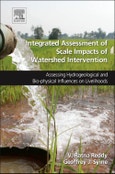- Integrates hydrogeology, bio-physical, and socioeconomic aspects of watersheds in a hydrological context
- Provides a comprehensive understanding of the impacts of watershed interventions
- Assesses the role of watershed interventions in enhancing household resilience
- Provides hydrological and socio-economic methodologies for design of sustainble watershed interventions including scale and institutional arrangements for implementing and sustaining watershed interventions
Table of Contents
- List of Contributors
- Foreword
- Acknowledgments
- Part I. Setting
- Chapter 1. Introduction
- 1.1. Background
- 1.2. Rainfed Agriculture and WSD in India
- 1.3. Watershed Policies in India
- 1.4. WSD and Importance of Scale
- 1.5. Need for an Integrated Approach
- 1.6. About this Book
- Chapter 2. Analytical Framework, Study Design, and Methodology
- 2.1. Introduction
- 2.2. Strategic Conceptual and Methodological Issues
- 2.3. Assessing Scale Impacts of WSD: An Analytical Framework
- 2.4. Biophysical Modeling
- 2.5. Assessing Socioeconomic Impacts
- 2.6. Model of Integration: The BNs
- 2.7. Equity and Justice Issues
- 2.8. Stakeholder Engagement
- 2.9. Approach and Sampling Design
- 2.10. Profile of Sample Sites
- Chapter 1. Introduction
- Part II. Hydro-geological and Bio-physical Aspects of the Watersheds
- Chapter 3. Investigating Geophysical and Hydrogeological Variabilities and Their Impact on Water Resources in the Context of Meso-Watersheds
- 3.1. Introduction
- 3.2. Study Areas
- 3.3. Materials and Methods
- 3.4. Results and Findings
- 3.5. Discussion
- 3.6. Zones Suitable for Different Types of Artificial Recharge Interventions
- 3.7. Conclusion
- Chapter 4. Application of a Simple Integrated Surface Water and Groundwater Model to Assess Mesoscale Watershed Development
- 4.1. Introduction
- 4.2. Model Development
- 4.3. Site Description and Model Parameterization
- 4.4. Results
- 4.5. Discussion
- 4.6. Conclusions
- Chapter 5. Modeling the Impact of Watershed Development on Water Resources in India
- 5.1. Introduction
- 5.2. Effective and Sustainable WSD: Hydrological Considerations
- 5.3. Study Sites in West Bengal
- 5.4. Data Collection
- 5.5. Modeling Hydrological Response
- 5.6. Application to Andhra Pradesh
- 5.7. Modification of the Original Model
- 5.8. Calibration and Validation Model on the Lakshmipuram Catchment
- 5.9. Applying the Model on an Ungauged Study Site in Andhra Pradesh
- 5.10. Discussion
- 5.11. Conclusion
- Chapter 6. Sustainable Watershed Development Design Methodology
- 6.1. Introduction
- 6.2. Methodology and Approach
- 6.3. Characterization of Biophysical Resources of the Study Sites
- 6.4. Description of HUNs
- 6.5. Land and Water Management Interventions through Watershed Programs
- 6.6. Assessment of Watershed Interventions on Hydrology of Watersheds
- 6.7. Conclusions
- Chapter 3. Investigating Geophysical and Hydrogeological Variabilities and Their Impact on Water Resources in the Context of Meso-Watersheds
- Part III. Socio-economic and Livelihood Impacts of Watersheds
- Chapter 7. Assessing Livelihood Impacts of Watersheds at Scale: An Integrated Approach
- 7.1. Introduction
- 7.2. Approach and Methods
- 7.3. Sample Selection and Profile of the Study Sites
- 7.4. Impact of WSD-The SRL Approach
- 7.5. Impact of WSD on Resilience
- 7.6. Factors Influencing Resilience
- 7.7. Conclusions
- Chapter 8. Evaluating the Determinants of Perceived Drought Resilience: An Empirical Analysis of Farmers' Survival Capabilities in Drought-Prone Regions of South India
- 8.1. Introduction
- 8.2. Methodology and Findings
- 8.3. Testing for the Impact of Watershed Interventions on Drought Resilience
- 8.4. Conclusion
- Chapter 9. Modeling Livelihood Indicators and Household Resilience using Bayesian Networks
- 9.1. Introduction
- 9.2. BNS
- 9.3. Capital Strength and Resilience BNS
- 9.4. Analyzing Social Capital using the BN Submodel
- 9.5. Synthesis
- Chapter 10. Justice and Equity in Watershed Development in Andhra Pradesh
- 10.1. Introduction
- 10.2. A Comparative Evaluation of the Concept of Justice in Water Resources Management in Australia and India: The Role of Participatory and Property Rights Approaches
- 10.3. Collective Action and Property Rights for Poverty Alleviation: A Conceptual Framework Based on the Experience of WSD in Semi-Arid India
- 10.4. Community Views on Collective Action and the Equity of the WSD Process
- 10.5. Conclusion
- Chapter 7. Assessing Livelihood Impacts of Watersheds at Scale: An Integrated Approach
- Part IV. Integrating Science into Policy and Practice
- Chapter 11. High Stakes-Engagement with a Purpose
- 11.1. Introduction
- 11.2. Actual Process Adopted in the Project
- 11.3. Outcomes of the Process Adopted and Lessons Learned
- 11.4. Model for Effective Stakeholder Engagement-Need for and Issues Involved in Closer Engagement with Stakeholders
- Chapter 12. Exploring Implications of Climate, Land Use, and Policy Intervention Scenarios on Water Resources, Livelihoods, and Resilience
- 12.1. Introduction
- 12.2. Analysis Tools
- 12.3. Biophysical Scenarios
- 12.4. Social Scenario
- 12.5. Synthesis
- Chapter 13. Summary and Conclusion
- 13.1. Background
- 13.2. Hydrogeology and Biophysical Aspects
- 13.3. Socioeconomic Implications
- 13.4. The Approach to Integration
- 13.5. Putting Science to Practice
- 13.6. The Way Forward
- Chapter 11. High Stakes-Engagement with a Purpose
- Index








